Rust Family Foundation: Archaeology Grants Program
Production
of Stone and State:
The Intersection of Ancient Maya Domestic and Institutional Economies
Principal Investigator:
Mary Clarke
Program of Archaeology, Boston University
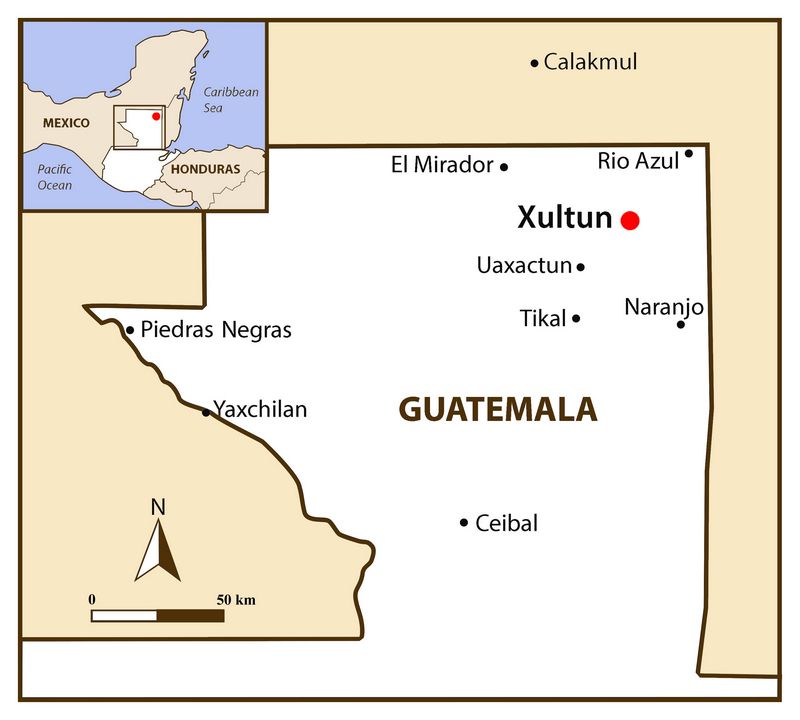
This project investigates the intersection of domestic and institutional Maya economies through the organization of monumental stone production, a system fundamentally linked to expressions of state power at the site of Xultun, Guatemala (Fig. 1). Monumental stone production, as a practice, includes quarrying or cutting megalithic stone blocks from bedrock, shaping their dimensions, and polishing and/or sculpting their surfaces (e.g., Abrams 1994; Clark and Houston 1998).
Fig.1: Map of the Maya Area with Xultun indicated.
Stone production is the preparatory stage of stones intended for state art or architecture and is a practice that can be found at all ancient Maya centers, large and small (e.g., Gallegos Gomora 1994; Robles García 1994; Titmus and Woods 1992). Despite the frequency of discovered quarries and quarry workshops, these data remain un-studied beyond experimental approaches that seek to quantify energetic values for labor (Abrams 1994; Ruiz 1985; Woods and Titmus 1996) or
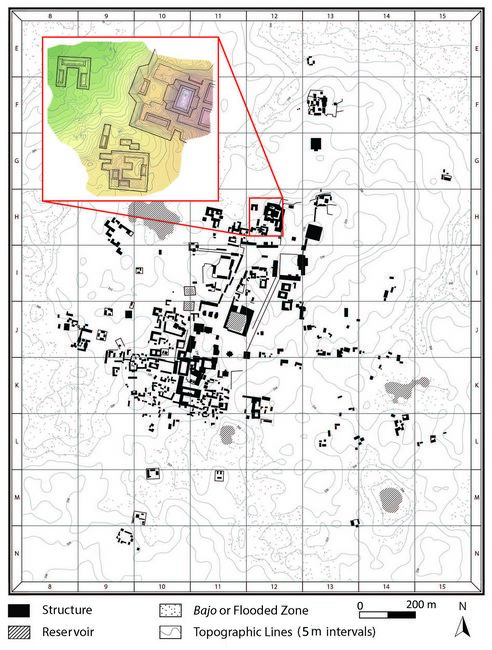 to test efficacy or wear patterns of stone tools (Titmus and
Woods 2002). While most scholars recognize that quarries are evidence
of power mechanisms where people became quantified labor, neither these
laborers nor their relationship with sponsoring state institutions have
been systematically studied in Mesoamerica through this rich dataset.
to test efficacy or wear patterns of stone tools (Titmus and
Woods 2002). While most scholars recognize that quarries are evidence
of power mechanisms where people became quantified labor, neither these
laborers nor their relationship with sponsoring state institutions have
been systematically studied in Mesoamerica through this rich dataset.
Fig.2: Map of Xultun with inset of the topographic map of the stone production district.
Fortunately, a well preserved stone-production district at Xultun—boasting a palatial center (Xul 12H4), an elite household (Xul 12H21), and a lesser elite residence (Xul 12H28)—provides an opportunity to empirically evaluate existing assumptions regarding the identity and class of laborers or non-specialized producers as well as details of a production process where producers obtained and produced objects that they themselves did not use (Clarke et al. 2016; Perez et al. 2016)..
Previous Research in the region
The site of Xultun was first excavated during the 2008 field season of the San Bartolo-Xultun Regional Archaeological Project (PARSB-X) under the direction of director Dr. William Saturno. While the project has had a long history of research with wide-ranging goals, the study of Xultun’s stone production began during the 2016 field season when survey and reconnaissance of the stone production district at Xultun was conducted (Fig. 2).
During this preliminary survey, multiple activity areas were discovered. Akin to other sites within the region, one activity area provides evidence on the extraction of stone for monumental architecture (Fig. 3) and was accompanied by tools for this work (e.g., tools for quarrying, cutting, and polishing stone). However, a rare example of a stela stone, found in situ, provides unparalleled evidence for the early stages of monumental art production (Fig. 4). Based on the location of these production areas, two architectural groups (defined by their arrangement around a shared and enclosed patio) were selected as the foci for initial excavations in 2016 (Fig. 2).

Fig.3: Cut blocks or architectural stones from the stone production district at Xultun (photograph by H. Perez, PARSB-X 2016).
Preliminary excavations served to establish the overall chronology and specific construction sequences of both groups as well as the residences of the populations that, in ancient Maya society, possibly worked within the identified production areas. In addition to the exciting finds of active production sites and residences, previous fieldwork resulted in a detailed topographic map and necessary architectural consolidation of fragile structures, setting the stage for the sponsored excavations.
Subsequent laboratory analyses conducted in the project’s laboratory in Antigua, Guatemala focused on the chronometric and modal analyses of pottery (Urquizú et al. 2016), the documentation of stone tools (Clarke et al. 2016), and the bioarchaeological analysis of human remains (Hotal
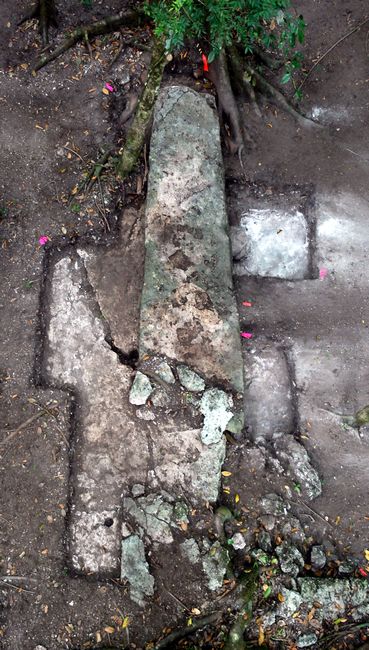 ing
and Suzuki 2016).
ing
and Suzuki 2016). Our pottery analysis confirmed that the excavated residential structures were, in fact, contemporaries during the Late Classic period (c. A.D. 600–900) (Urquizu et al. 2016; Urquizu et al. 2017; see fig.8 below for more details on pottery typology). Additionally, the documentation of the stone tools has aided typological comparisons that link the production activities of Xultun to domestic and funerary contexts at the neighboring site of Tikal (Moholy-Nagy 1967). This comparison will prove significant in contextualizing Xultun finds and perhaps revising earlier interpretations of occupation and social class (Becker 1973; Haviland 1974).
.
Fig.4: Large stela stone in the process of extraction from bedrock from the stone production district at Xultun (photography by H. Perez, PARSB-X 2016).
Current Project:
Goals:
• Conduct horizontal excavations in the Xul 12H28 group.
• Collect evidence detailing the identity of the household associated with this group (i.e., laborers, stone carvers, etc.).
• Collect evidence detailing the occupations of household members.
2017 Funded Research Project (RFF-2017-35)
During the 2017 field season, our goal was to expand the sampled households so that it included three residential groups of differing constructed volumes as scale has the potential to represent variability in social-economic difference. The RFF funds supported excavations in the smallest group in the stone production district, Xul 12H28. Here we sought to define the group’s architecture and its features (e.g., masonry style, interior architecture, etc.), collect material to date the phases of construction, and identify cultural practices, areas of activity, and occupation of residents. These results will subsequently be used in a district-wide comparison of consumption patterns and occupation in order to evaluate the economic relationships stone producers maintained with the Xultun state.
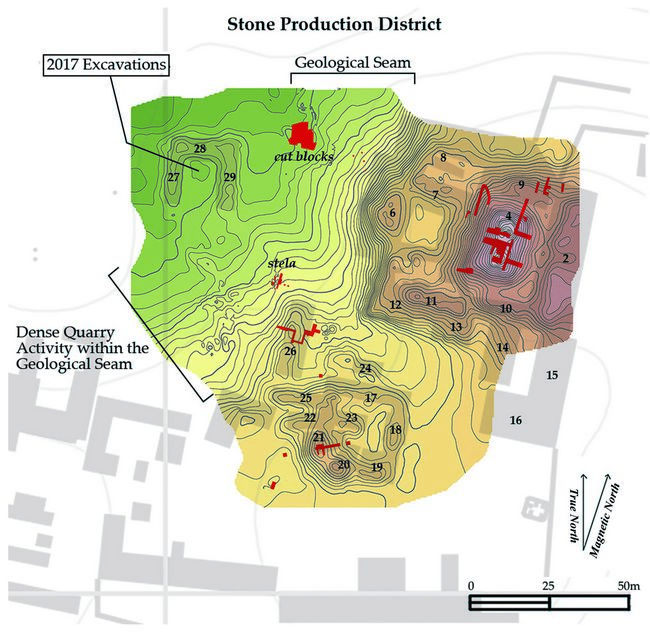 Fig.5: Areas
of Investigation within the Stone Production District with the 2016
excavations indicated in red (Map by C.R. Chiriboga, modified by M.
Clarke, PARSB-X 2016).
Fig.5: Areas
of Investigation within the Stone Production District with the 2016
excavations indicated in red (Map by C.R. Chiriboga, modified by M.
Clarke, PARSB-X 2016).Methodology:
The residential group Xul 12H28 was investigated using traditional horizontal excavation methods. Primary excavation tools included picks, shovels, trowels, brushes, buckets, and screens. During the excavations we used cultural levels for stratigraphic control until we encountered production locations or dense layers of cultural activity. In these instances, arbitrary levels of 10 cm were used. Documentation included illustration, photography, and mapping of unit profiles, plans, and features, as well as completing lot forms and maintaining a journal. Additionally, the activity areas were mapped using a total station and tied into ArcGIS in order to view the spatial distribution of domestic and production activities. Materials collected in the field were washed, labeled, weighed, and catalogued. Subsequent to the field, pottery underwent typological classification. For details on this method see our project’s 2016 report on its pottery analysis (Urquizú et al. 2016).
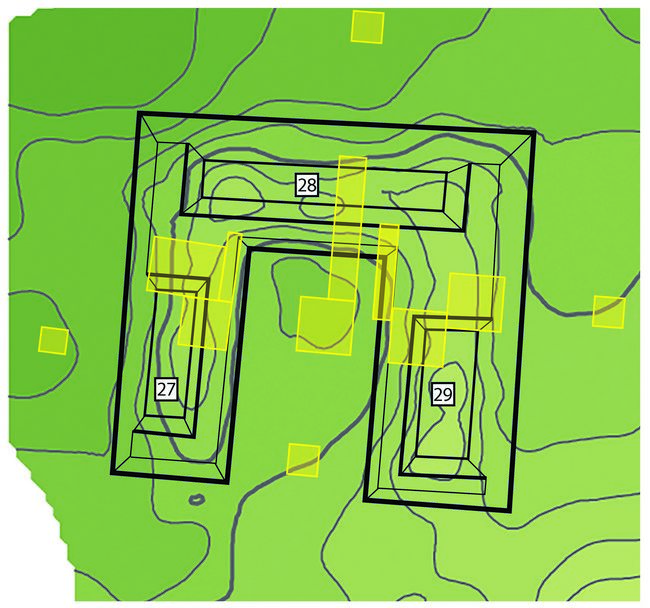
In addition to horizontal excavations at group Xul 12H28, and test pits were made in the surrounding patio and exterior areas. Cultural levels were used for stratigraphic control until production locations or dense layers of cultural activity were encountered, when arbitrary levels of 10 cm were used. Documentation included illustration, photography, and mapping of unit profiles, plans, and features. Activity areas were mapped using a total station and tied into ArcGIS in order to view the spatial distribution of domestic and production activities.
Fig.6: Areas of Investigation within the Stone Production District with the 2017 excavations indicated in yellow (Map by C.R. Chiriboga, modified by M. Clarke, PARSB-X 2016).
Findings:
The area of investigation was mapped for the first time during the 2016 field season. Structures 12H27, 12H28, and 12H29 are not large mounds and are located in and around limestone quarries at the base of a slope at the height of which structure 12H4 is located (Fig. 5). Perhaps because of their diminutive size or location the structures were not included in earlier maps of the 12H quadrant and were not a focus of looting like so many structures at Xultun. Thus the 2017 investigations into these structures provided an opportunity to better understand the domestic side of life within a stone production district (Fig. 6).
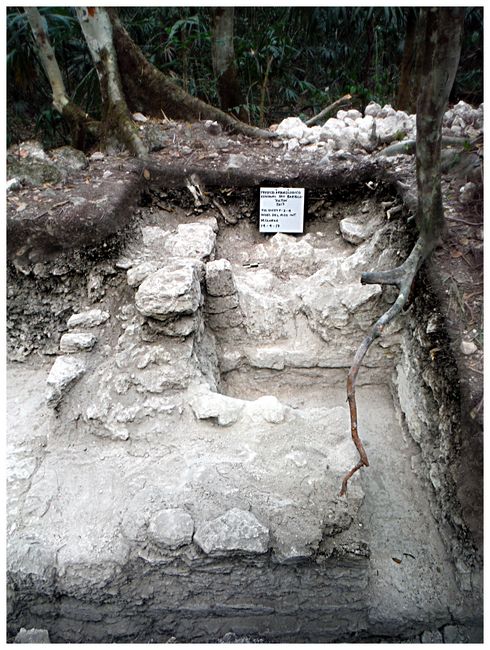 The
focus of excavation was a group of structures located on the quarry
level; the level where stone was being cut, extracted, and carried off
to other production or construction sites (Fig. 6). The group is
comprised of three connected platforms that create a “U” shape. Each
platform was excavated to identify the related architectural features,
such as rooms, benches, doorways, etc. The presence of trees, both
living and collapsed, determined the location and extent of excavation
as the tree roots extended into the shallow mounds.
The
focus of excavation was a group of structures located on the quarry
level; the level where stone was being cut, extracted, and carried off
to other production or construction sites (Fig. 6). The group is
comprised of three connected platforms that create a “U” shape. Each
platform was excavated to identify the related architectural features,
such as rooms, benches, doorways, etc. The presence of trees, both
living and collapsed, determined the location and extent of excavation
as the tree roots extended into the shallow mounds. Fig.7: Excavations of the room built on Structure Xul 12H27 with the walls, doorway, and interior bench visible. (Photograph by M. Clarke, PARSB-X 2017)..
The excavations into each structure were able to identify architecture that can be defined as domestic, specifically rooms with benches for sleeping (Fig. 7). The differences between the structures were minimal, though the dimensions of the 12H29 room (XUL 12H29-F-1 and XUL 12H29-F-2) show a significantly larger space with a similarly large bench.
The pottery recovered (n=2180) during excavation was analyzed using the type-variety method and consisted of predominately eroded ceramic material (Fig. 8) (Urquizu et al. 2017). While the eroded material could not be identified to types, the data regarding form was re
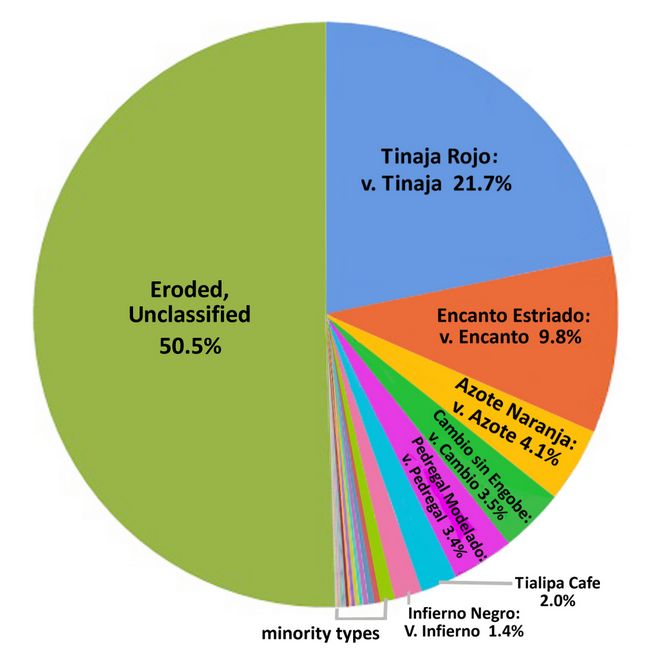 corded.
The remaining 49.5% of the sample illustrates a distribution of Late
Classic period pottery with two dominant types: Tinaja Rojo (21.7%) and
Encanto Estriado (9.8%).
corded.
The remaining 49.5% of the sample illustrates a distribution of Late
Classic period pottery with two dominant types: Tinaja Rojo (21.7%) and
Encanto Estriado (9.8%). Fig.8: The Type-variety pottery distribution for the Late Classic period occupation of the 12H28 Group. After Infierno Negro the quantities drop (shown as "minority types" in fig.8): Camarón Inciso: v. Camarón n=17, Tinaja Rojo: v. Subín Rojo n=8, Harina Crema: v Harina n=7, Chinja Impreso: v. Chinja n=6, Saxche-Palmar: v. Saxche Palmar n=5, Aduana Rojo: v. Aduana n=5, Pantano Impreso: v. Impreso n=4, Belice Rojo: v. Belice n=3, Polícromo Erosionado n=3, Zacatal Crema Polícromo: v. Zacatal n=2, Negro s/Rojo: v. No Especificada n=2, Salada Acanalado: v. Salada n=2, and then n=1 for Manteca Impreso: v. Manteca, Carmelita Inciso: v. Carmelita, Leona Rojo S/Naranja: v. Leona, Chinos Negro s/Crema: v. Chinos, Subín / Chaquiste, Corozal Inciso: v. Corozal, Torres Inciso: v. Torres, and Tenaja Acanalado.
Chipped stone tools were recovered (n=23), including hammer stones (n=9) and bifaces (n=10). Only a few chert blades were uncovered (n=4). The only example of jade was found in the central patio and illustrates the process of creating a jade inlay for dental ornamentation (Fig. 9).
In the structures 12H27, 12H28, and 12H29, burials were notably absent. It is common to find burials within the patio floors, inside of sleeping benches, and, in some cases, below the floors of a room (McAnany 1995). However, no remains were identified despite the clear domestic nature of the architecture. Additionally, in the neighboring residential groups, burials were identified in bench constructions and platform levels. Significant among these neighboring burials were those found removed in the residences in structure 12
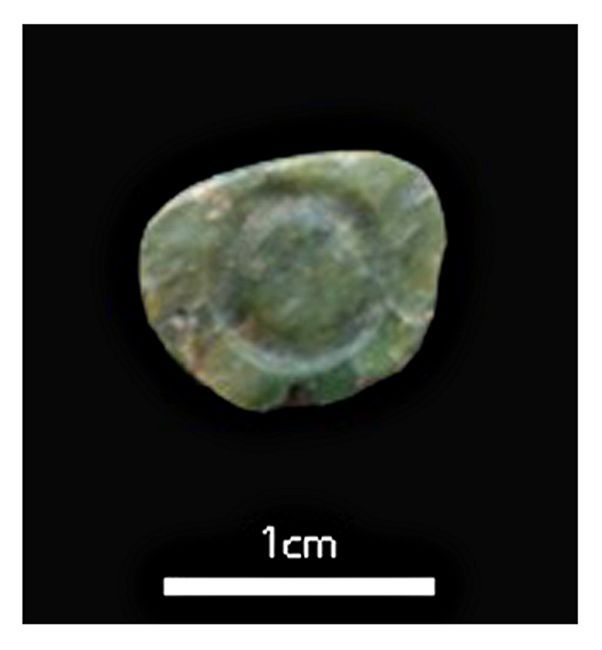 H17.
Here the ancient Maya broke through their bench constructions to remove
the remains of possible family members, a practice that has been
previously identified (McAnany 1995). In the area of study, the bedrock
served as the patio floor and the interior spaces of the rooms,
specifically the floors and benches, did not show signs of burial or
exhumation. It is possible that in the unexcavated areas of these
features burials may be found, however, their absence could suggest a
different domestic organization, perhaps a seasonal occupation or
linked to some other of type temporary or secondary inhabitance.
H17.
Here the ancient Maya broke through their bench constructions to remove
the remains of possible family members, a practice that has been
previously identified (McAnany 1995). In the area of study, the bedrock
served as the patio floor and the interior spaces of the rooms,
specifically the floors and benches, did not show signs of burial or
exhumation. It is possible that in the unexcavated areas of these
features burials may be found, however, their absence could suggest a
different domestic organization, perhaps a seasonal occupation or
linked to some other of type temporary or secondary inhabitance.Fig.9: Scan of the modified jade artifact that appears to show the preparatory stages of production for a jade dental inlay. (Photograph by M. Clarke, PARSB-X 2017)
The quantities and locations of material culture from the excavated areas support the notion that this group was abandoned without a discernable threat, such as those seen in rapidly abandoned contexts (Inomata et al. 2002). Interior spaces were swept clean and household items that were to be left behind at the time of abandonment were scattered and broken outside of the house in the shared patio. Conversely, the neighboring limestone production areas present evidence of commissioned work left unfinished alongside lithic artifacts associated with stone workers’ tool kits. Significantly, the ceramic materials in both household and quarry contexts date to the Late Classic period, although the sample collected in the production contexts were highly eroded (14% of the sample could be dated to the Late Classic period, while 86% was eroded). If both areas were abandoned during the same event, then a few interpretations can be made. Perhaps quarrying tool kits were not seen as essential items at the time of abandonment and were therefore left behind. It is also possible that the population using the quarry tools did not live near the quarry. If this were the case, they may not have returned to the production area prior to migration.
Conclusions:
During the 2017 field season at Xultun, the investigations into the three structures 12H27, 12H28, and 12H29 were able to confirm the existence of residential architecture adjacent to the quarries identified in the previous field season. The questions that these excavations aimed to address were 1) whether or not people were living in and around the quarries within the stone production district and 2) was there a direct relationship between the population residing in the houses bordering the quarries and the population performing the quarrying and stone production work.
The first question was easily confirmed by the form of architecture in conjunction with the type of material culture and abandonment behavior that is consistent with ancient Maya households. The second question remains at issue. Future research for this project aims to further contextualize these findings in the Xul 12H28 group with the neighboring groups in the stone production district, with other residential groups at Xultun, and nearby Maya centers where quarry toolkits have been identified.
References:
Abrams, E.
1994 How the Maya Built their World. University of Texas Press, Austin.
Becker, M.J.,
1973 Archaeological Evidence for Occupational Specialization among the Classic Period Maya at Tikal, Guatemala. American Antiquity 38(4): 396–406.
Clark, J.E., and S.D. Houston.
1998 Craft Specialization, Gender, and Personhood Among the Post-Conquest Maya of Yucatan, Mexico. In Craft and Social Identity, pp. 31–46, edited by Cathy L. Costin and Rita T. Wright, Washington, DC: Archaeological Papers of the American Anthropological Association No. 8.
Clarke, M., R. Gill, and E. Nahil
2016 Excavaciones en el Cuadrante 12H, Xultun. In Proyecto Arqueologico Regional San Bartolo-Xultun: Informe de Resultados de Investigaciones Temporada de Campo No. 13, Año 2016, edited by Boris Beltran and William Saturno. Report to the Instituto de Antropologia e Historia de Guatemala, Guatemala City.
Gallegos Gomora, M.J.
1994 Explotación de Piedra Caliza en el Peten Campechano. Mayab 9: 8–17.
Haviland, W.A.
1974 Occupational Specialization at Tikal, Guatemala: Stoneworking-Monument Carving, American Antiquity 39(4): 494–496.
Hotaling, J. and S. Suzuki
2016 El Estudio Bioarqueológia de los Restos Encontrados en el Sitio Arqueologico Xultun, Peten. Temporadas 2014 y 2016. Report to the Instituto de Antropologia e Historia de Guatemala, Guatemala City.
Inomata, T., D. Triadan, E. Ponciano, E. Pinto, R.E. Terry, and M. Eberl
2002 Domestic and political lives of Classic Maya elites: The excavation of rapidly abandoned structures at Aguateca, Guatemala. Latin American Antiquity, 13(3): 305–330.
McAnany, P.
1995 Living with the Ancestors: Kinship and Kingship in Ancient Maya Society. University of Texas Press, Austin.
Moholy-Nagy, H.
1967 Tikal Report No. 27, Part B: The Artifacts of Tikal: Utilitarian Artifacts and Unworked Material. William A. Haviland and Christopher Jones (eds.). Philadelphia: Univ.of Pennsylvania Museum of Archaeology and Anthropology Press.
Perez, H, J. Camilo, K. Martinez, and D. Garcia
2016 Excavaciones en la Estructura 12H4, Xultun. In Beltran and Saturno (eds.), op. cit, pp.
Robles García, N.M.
1994 Las Canteras de Mitla, Oaxaca: Tecnología para la Arquitectura Monumental. Vanderbilt University.
Ruiz, M.E.
1985 Observaciones Sobre Canteras en Petén, Guatemala. Mesoamérica 10:421–449.
Titmus, G.L. and J.C. Woods
1992 Operación Q206: Una cantera caliza. En Informe de las investigaciones realizadas en la Temporada de 1991 en el sitio arqueológico Nakbe, Petén, Guatemala, R. D. Hansen (ed,), Entregado al Instituto de Antropología e Historia.
Urquizú, M., M. Clarke, H. Perez, and A. Cordero
2016 La Cerámica de Cuadrante 12H. In Proyecto Arqueologico Regional San Bartolo-Xultun: Informe de Resultados de Investigaciones Temporada de Campo No. 13, Año 2016, edited by Boris Beltran and William Saturno. Report to the Instituto de Antropologia e Historia de Guatemala, Guatemala City.
Urquizú, M., B. Beltran, A. Cordero, and H. Perez
2017 La Cerámica. In Proyecto Arqueologico Regional San Bartolo-Xultun: Informe de Resultados de Investigaciones Temporada de Campo No. 14, Año 2017, edited by Boris Beltran and William Saturno. Report to the Instituto de Antropologia e Historia de Guatemala, Guatemala City.
Woods, James C. y Gene L. Titmus
1996 Stone on Stone: Perspectives of Maya Civilization from Lithic Studies. Eighth Palenque Round Table, 1993, pp. 479–489, edited by M. G. Robertson, M. J. Macri and J. McHargue. Pre-Columbian Art Research Institute, San Francisco.
.
Recent Foundation grants: general Archaeology Grants Program w/map
Copyright © 2018 Rust Family Foundation